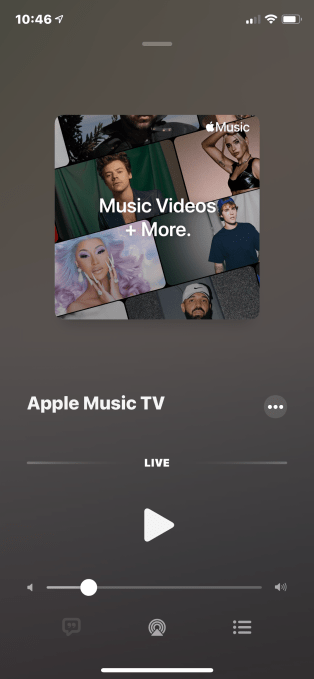Apple is expanding its investment in music with today’s launch of “Apple Music TV.” The new music video station offers a free, 24-hour live stream of popular music videos and other music content, including exclusive video premieres, curated music video blocks, live shows, fan events, chart countdowns and guest appearances.
The service doesn’t have its own dedicated app, but is instead offered as a new feature within two of Apple’s existing entertainment apps. At launch, you can watch Apple Music TV from within the Browse tab of either the Apple Music app or the Apple TV app. (Accessible via apple.co/AppleMusicTV).
While Apple Music is a paid subscription service, Apple Music TV will be free to users in the U.S., the company says.
To kick off its launch, Apple Music TV today began with a countdown of the top 100 most-streamed songs ever across all of Apple Music, based on U.S. data.
During brief tests of the new service, we found it to be a fairly basic — though uncensored and ad-free — experience. The video stream only offered artist and song details at the beginning, instead of as the music played. It also didn’t take advantage of the integration with Apple Music to offer additional features to paying subscribers — like being able to favorite the song or add it to a playlist, for instance.
The stream would stop when the Apple Music app was closed, as it didn’t support background play.

Image Credits: Apple
There also weren’t any on-screen tools to share what you were watching via a social media post. You had to dig to find the “share” button under the three-dot, “more” menu. This would give you a link to tweet, but wouldn’t pre-fill it with text or hashtags, like the artist name or song.
While listening, you could stop the live stream and then return after a short pause. But after a bit, the stream disconnects and the thumbnail of the paused music video reverts to the placeholder Apple Music TV image. When live, the text and icons will be shown in red. They revert to white when you’ve disconnected, as a visual cue.
Despite its simplicity, Apple Music TV gives Apple an immediate new home for its music-related original content, which over the years has included exclusive interviews, concert films and more. It also provides Apple with another advantage when it goes to negotiate with artists for their premieres, as it introduces an additional platform for reaching an artist’s fans — not only with the premiere itself, but by offering artists blocks of airtime leading up to their next debut that they can use to promote their releases.
The new station can also leverage content produced for the Apple Music 1 (formerly Beats 1) radio station, as it goes about running these promotions.
For example, on Thursday, October 22, Apple Music TV will promote the upcoming release of Bruce Springsteen’s “Letter to You” with music video blocks featuring his greatest videos, plus an exclusive interview with Zane Lowe, and a special live stream fan event.
Apple says that Apple Music 1 won’t be producing exclusive content for the live-streamed station, but instead will run the video content it already produces across its radio stations — Apple Music 1, Apple Music Country, and Apple Music Hits — as interstitial content on Apple Music TV.
Fridays, meanwhile, will focus on new music. This Friday, October 23, at 9 AM PT, Apple Music TV will showcase two new exclusive video premieres — Joji’s “777” and SAINt JHN’s “Gorgeous.”
Apple Music TV’s biggest advantage, of course, is the fact that it’s freely accessible to millions of Apple device owners.
But it may struggle for traction as it lacks the features that make other live stream fan events or premieres engaging — like group chats or direct interactions with creators.
Instead, it’s more like a traditional TV broadcast — even MTV-like — compared with other online destinations where artists today connect with fans and promote their albums, like YouTube, VEVO or, more recently, Facebook, which just this year launched music videos.
Apple didn’t say if it planned to expand the new station outside the U.S.

Recent Comments